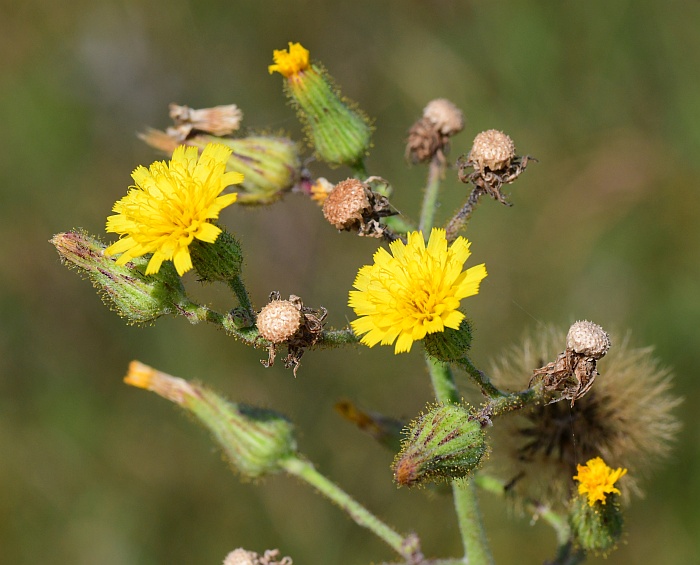Hieracium longipilum Torr. ex Hook.
Long-haired Hawkweed

Native
CC = 6
CW = 5
MOC = 36
© SRTurner
Hieracium longipilum Torr. ex Hook.Long-haired Hawkweed | |
 |
Native CC = 6 CW = 5 MOC = 36 |
© SRTurner |
|
Family - Asteraceae/Cichorieae Habit - Perennial forb with a short, ascending to spreading, occasionally branched rootstock. Stems - Mostly solitary, 50-170 cm long, densely pubescent with white to light orangish brown, spreading to loosely ascending hairs 10-20 mm long having a bulbous or slightly expanded base, these becoming sparser toward the tip, usually also inconspicuously pubescent with cobwebby, minute, branched hairs, often also with sparse, gland-tipped hairs toward the tip.
Leaves - Basal leaves often persistent at flowering, mostly short-petiolate, the blade 5-30 cm long, narrowly oblanceolate to oblanceolate or obovate, rounded to sharply pointed at the tip, the surfaces and margins pubescent with dense, more or less spreading, bulbous-based hairs (these sometimes somewhat shorter than those of the stem) and rarely also sparse, minute, inconspicuous, branched hairs. Stem leaves usually several, similar to the basal leaves but gradually reduced in size, more often sessile, oblanceolate to narrowly oblanceolate, the base usually not clasping the stem.
Inflorescences - Elongate cylindrical panicles or occasionally only spikelike racemes of flowering heads.
Heads - Involucre 7-10 mm long, the inner series of bracts narrowly oblong-lanceolate, pubescent with inconspicuous, cobwebby, branched hairs and longer, spreading, usually dark-colored, gland-tipped hairs, the outer series variable and grading into the inner series, some of the bracts more than 1/2 as long as those of the inner series.
Florets - Ligulate florets 40-90 per head. Corollas 7-9 mm long, yellow. Pappus bristles 5-7 mm long, light yellowish to orangish brown.
Fruits - Achenes 3.0-4.5 mm long, somewhat tapered to the slightly expanded tip.
Flowering - May - October. Habitat - Upland prairies, openings of dry upland forests, old fields, railroads, and roadsides. Origin - Native to the U.S. Lookalikes - Other members of the Hieracium genus, particularly H. gronovii. Other info. - This interesting and well-named plant is found in Missouri mostly in a wide band extending from the northeastern to southwestern portions of the state. Beyond Missouri the range further extends into Michigan and Wisconsin to the northeast, and southern Oklahoma to the southwest. In Missouri it is less frequently encountered than the very common H. gronovii, which it closely resembles. Its primary distinguishing feature is the very long hairs present, especially on the lower part of the stem. These exceed 10 mm in length. The length should be carefully noted, as H. gronovii is often also conspicuously hairy. As with other members of the genus, the plants have milky sap. Photographs taken at Schuette Prairie, Polk County, MO, 8-6-2024; and at Twenty-Five Mile Prairie, Polk County, MO, 8-6-2024 (SRTurner). |